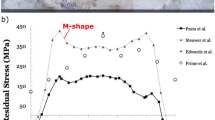Abstract
A titanium midtank strut support from the Columbia space shuttle was submitted for failure analysis. Stereomicroscopy, light optical microscopy, and scanning electron microscopy with energy-dispersive spectroscopy were used to investigate the failed part. Evidence of melting was found on the fracture surface. Additionally, the high temperature associated with the melting was combined with cooling from the β-phase field, as indicated by the formation of a martensitic microstructure in the surrounding material. Craters were found on the surface of the part due to impact of foreign particles containing iron, nickel, and chromium. Failure of the titanium strut support was due to the severe high temperatures encountered as a result of the shuttle breakup and re-entry into the earth’s atmosphere.
Similar content being viewed by others
References
Columbia Accident Investigation Board (CAIB): Report Volume 1, NASA, Aug 2003.
B.M. Mayeaux, T.E. Collins, G.A. Jerman, S.J. McDanels, R.S. Piascik, R.W. Russell, and S.R. Shah: “Materials Analysis: A Key to Unlocking the Mystery of the Columbia Tragedy,” J. Met., Feb 2004, p. 20.
Author information
Authors and Affiliations
Rights and permissions
About this article
Cite this article
Butler, C., Deacon, R.M. & Marder, A.R. Failure analysis of a titanium strut tank support in the space shuttle Columbia . J Fail. Anal. and Preven. 6, 51–54 (2006). https://doi.org/10.1361/154770206X86491
Received:
Revised:
Issue Date:
DOI: https://doi.org/10.1361/154770206X86491




